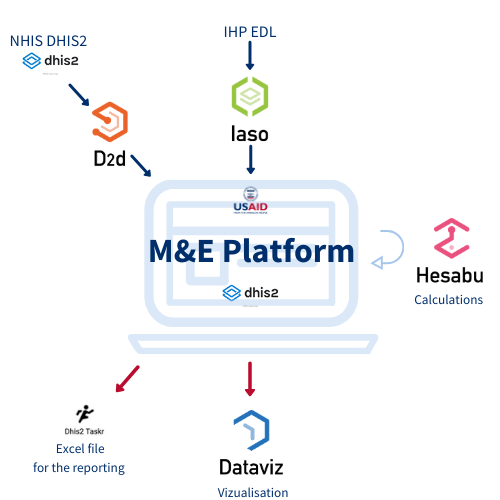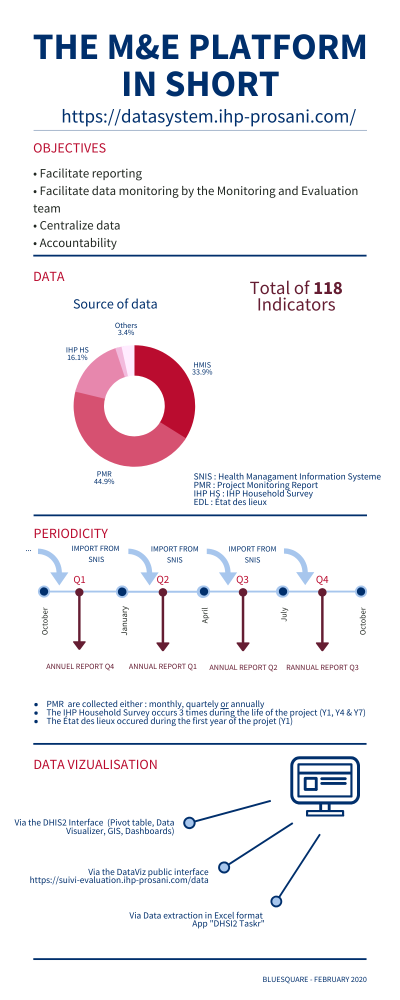Centralizing monitoring and evaluation data for the USAID IHP in DRC
The IHP USAID program (in French PROSANI USAID) aims at strengthening the health system in the Democratic Republic of Congo. It is funded by the US Development Agency (USAID) in close collaboration with the government of the country. The program focuses on maternal and child health, family planning, nutrition, malaria, tuberculosis and HIV.
Bluesquare, as the program’s partner for data management and the development of digital tools, has provided support in three key areas.
- Facilitate the data collection and analysis process for the program’s 118 indicators to support the general monitoring and evaluation needs.
- Centralize all data collected as part of the program (inventory, household survey, quarterly report, etc.)
- Implement dashboards that can be made available to program technical advisors.
DHIS2… and more
Bluesquare has therefore developed the Mesure & Evaluation Platform (M&E Platform) for this program. Similar to a conventional DHIS2 platform, it includes some additional applications to support the specific needs of IHP USAID:
- D2D: to transfer data in just one click directly from the official Health Management Information System DHIS2 (National HMIS DHIS2) to IHP DHIS2 – especially for all M&E indicators that rely on national data;
- Iaso: to transfer Etat des Lieux data to IHP DHIS2;
- Hesabu : to calculate the most complex indicators of the logical framework and store the results in the IHP DHIS2;
- DataViz : to present selected data on a public “user-friendly” interface in order to share the program’s results: https://suivi-evaluation.ihp-prosani.com/data.

A secure and reliable platform
Access to the M&E Platform is ID and password protected. These can be provided upon request by the M&E team. Each user is assigned one (or more) role(s) based on what they will need to work on in the platform. This approach helps to limit the risk of errors that could cause problems later when using the tool.
In the case of this platform, 4 roles have been defined that can be combined by need and by geographic areas in order to further limit the risk of error (for example: encode data for a province difference from your own): Input, Visualization, Analyst, Superuser.
Data extraction for the development of project evaluation indicators
The source of data
A total of 118 indicators are used to assess IHP USAID’s progress. These indicators are calculated based on data from a variety of sources. The more sources there are for the data the richer the insights we can gather from these indicators. The integration includes mainly the data collected by the Ministry of Health (available in the National DHIS2 HMIS) and some additional data from the project (Project Monitoring Report – PMR data). Thanks to the tools described above, Bluesquare was also able to enrich this with additional data from one-off surveys (IHP Household Surveys or data being collected by the Ministry of Health to evaluate the status of the health system at any given time called “Etat des lieux”) as well as other external surveys and disease specific databases.
Ensure a very large amount of data extraction
Using the D2D tool, Bluesquare will extract these different data and merge them with IHP DHIS2 data.
To provide a sense of the process to manage such complex routine data integration we herewith provide an overview of the transactions and some data security measures put in place to ensure quality data exchanges.
- Data from the National health information system (HMIS) are imported quarterly from a copy of the DHIS2 SNIS (so as not to endanger the proper functioning of the real DHIS2 HMIS during the data transfer). This also means that the HMIS data is not updated on a daily basis and thus remains “fixed” once imported into the platform which allows for methodological consistency to be maintained in trends analysis. The HMIS DHIS2 remains an essential data source for day-to-day data analysis and to observe “absolute” figures.
- Data from the Project Monitoring Report (PMR) are added directly to the M&E Platform via data collection forms available on a monthly, quarterly or annually basis depending on the monitoring needs of the M&E team.
- Data from État des Lieux (EDL) This data is collected in a tool called IASO, that collects and manages the data in parallel to the DHIS2.
- The remaining data (IHP Household survey and other sources) are manually imported into the IHP DHIS2 by the Bluesquare team.
How the platform will be implemented going forward
The M&E Platform is now being used for ongoing reporting.
To ensure the tools meet the user needs, run smoothly and capture data effectively, the M&E leads will test the PMR data entry forms on a provincial level. This evaluation of user needs will play a key role in the next iteration of potential improvements to ensure the quality of the data captured for the program monitoring remains consistent.
Additional dashboards will also be developed by the Bluesquare team to help M&E teams capture and visualize the essential information on the definition of indicators.
And the M&E platform itself will continue to be adapted thanks to ongoing dialogue and discussions on the tool, its use and its effectiveness to be sure it continues to meet the needs of the IHP USAID team.
